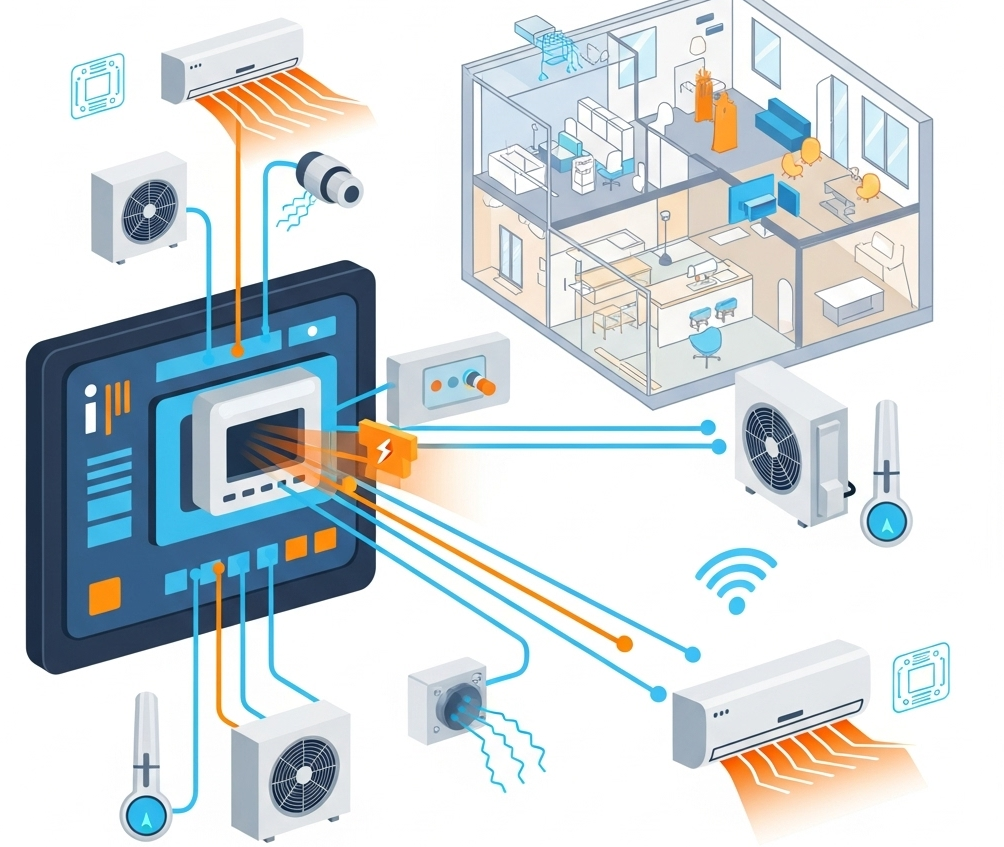
In today’s rapidly evolving technological landscape, smart HVAC (Heating, Ventilation, and Air Conditioning) systems and IoT (Internet of Things)-connected devices are transforming how businesses manage energy, optimize operations, and enhance sustainability. These advanced systems rely on interconnected sensors, data analytics, and automation to improve efficiency and reduce costs. However, the successful adoption of these technologies hinges on an often-overlooked function: procurement. Procurement plays a pivotal role in ensuring organizations acquire the right technologies, manage supply chain risks, and align with strategic goals. This blog post explores how procurement enables the deployment of smart HVAC and IoT-connected systems and why it’s critical to their success.
Smart HVAC systems use advanced sensors, controls, and IoT connectivity to monitor and adjust heating, cooling, and ventilation in real time. These systems optimize energy usage, improve indoor air quality, and reduce maintenance costs by leveraging data-driven insights. IoT-connected systems, more broadly, integrate devices like smart thermostats, lighting, and security systems into a cohesive network, enabling centralized control and automation.
For example, a smart HVAC system might detect occupancy patterns in an office building and adjust temperature settings to save energy during off-hours. IoT platforms can further integrate HVAC data with other building systems, providing a holistic view of operational performance. However, deploying these systems requires careful planning, sourcing, and implementation—tasks where procurement shines.
Procurement is no longer just about purchasing goods and services; it’s a strategic function that drives innovation, cost efficiency, and risk management. When it comes to smart HVAC and IoT-connected systems, procurement professionals are instrumental in several key areas:
Procurement teams are responsible for identifying and vetting vendors who provide cutting-edge HVAC and IoT solutions. This involves evaluating suppliers based on product quality, scalability, interoperability, and compliance with industry standards like ASHRAE or IoT security protocols. By conducting thorough market research and engaging in competitive bidding, procurement ensures organizations invest in reliable, future-proof technologies.
For instance, a procurement team might compare IoT platforms to ensure compatibility with existing building management systems (BMS) or verify that a smart HVAC system supports open protocols like BACnet or Modbus for seamless integration.
Smart HVAC and IoT systems often require significant upfront investment, but their long-term benefits—energy savings, predictive maintenance, and improved occupant comfort—justify the cost. Procurement professionals analyze the TCO, factoring in installation, maintenance, software subscriptions, and energy savings. By negotiating favorable contracts and exploring financing options like leasing or energy-as-a-service models, procurement can make these technologies more accessible.
The global supply chain for IoT devices and HVAC components can be complex, with risks like semiconductor shortages or geopolitical disruptions. Procurement teams mitigate these risks by diversifying suppliers, securing long-term contracts, and ensuring timely delivery of critical components like sensors, controllers, or cloud infrastructure. They also verify that vendors adhere to cybersecurity standards to protect IoT networks from vulnerabilities.
Sustainability is a top priority for modern organizations, and smart HVAC systems play a key role in reducing carbon footprints. Procurement ensures that purchased systems meet energy efficiency standards, such as ENERGY STAR certification, and comply with environmental regulations like the EU’s F-Gas regulations or local building codes. By prioritizing eco-friendly vendors and technologies, procurement aligns with corporate sustainability goals.
Deploying smart HVAC and IoT systems requires coordination across departments—facilities management, IT, finance, and sustainability teams. Procurement acts as a bridge, facilitating communication and aligning stakeholder needs. For example, IT may prioritize cybersecurity, while facilities teams focus on system performance. Procurement ensures that vendor contracts address these diverse requirements and supports training or change management to ease adoption.
While procurement is critical to success, it faces several challenges:
Complexity of Technology: IoT and smart HVAC systems involve intricate hardware and software ecosystems. Procurement teams need technical expertise to evaluate solutions and avoid vendor lock-in.
Cybersecurity Risks: IoT devices are vulnerable to cyberattacks, requiring procurement to prioritize vendors with robust security measures, such as end-to-end encryption or regular firmware updates.
Integration Issues: Legacy systems may not be compatible with new IoT platforms, requiring procurement to source retrofit solutions or middleware.
Budget Constraints: Balancing upfront costs with long-term savings can be challenging, especially for organizations with limited capital.
To overcome these challenges, procurement teams should collaborate closely with technical experts, conduct pilot projects, and leverage data from industry reports or case studies to make informed decisions.
To maximize the value of smart HVAC and IoT-connected systems, procurement teams should adopt the following best practices:
Develop a Clear Strategy: Align procurement goals with organizational objectives, such as energy efficiency or digital transformation. Create a roadmap for technology adoption, including timelines and budgets.
Engage Early with Stakeholders: Involve facilities, IT, and sustainability teams early in the procurement process to define requirements and avoid misaligned purchases.
Prioritize Interoperability: Choose systems that support open standards and can integrate with existing infrastructure to avoid costly replacements.
Focus on Lifecycle Management: Consider maintenance, upgrades, and end-of-life disposal when selecting vendors to ensure long-term value.
Leverage Data and Analytics: Use market intelligence and IoT pilot data to inform vendor selection and negotiate better terms.
As smart HVAC and IoT technologies evolve, procurement’s role will become even more critical. Emerging trends like artificial intelligence (AI) for predictive maintenance, 5G-enabled IoT networks, and digital twins will require procurement teams to stay ahead of the curve. By fostering partnerships with innovative vendors and investing in upskilling, procurement can drive the adoption of next-generation systems that deliver operational excellence and sustainability.
Procurement is the backbone of successful smart HVAC and IoT-connected system deployments. By strategically sourcing technologies, managing risks, and aligning with organizational goals, procurement teams enable businesses to unlock the full potential of these transformative systems. As the demand for energy-efficient, connected buildings grows, procurement professionals will play an increasingly vital role in shaping a smarter, more sustainable future.
© 2025 Lasso Supply Chain Software LLC
Get instant access to our report on the Top Procurement Trends of 2025.
Get instant access to our report on the Top Procurement Trends of 2025 by filling out the form below.
